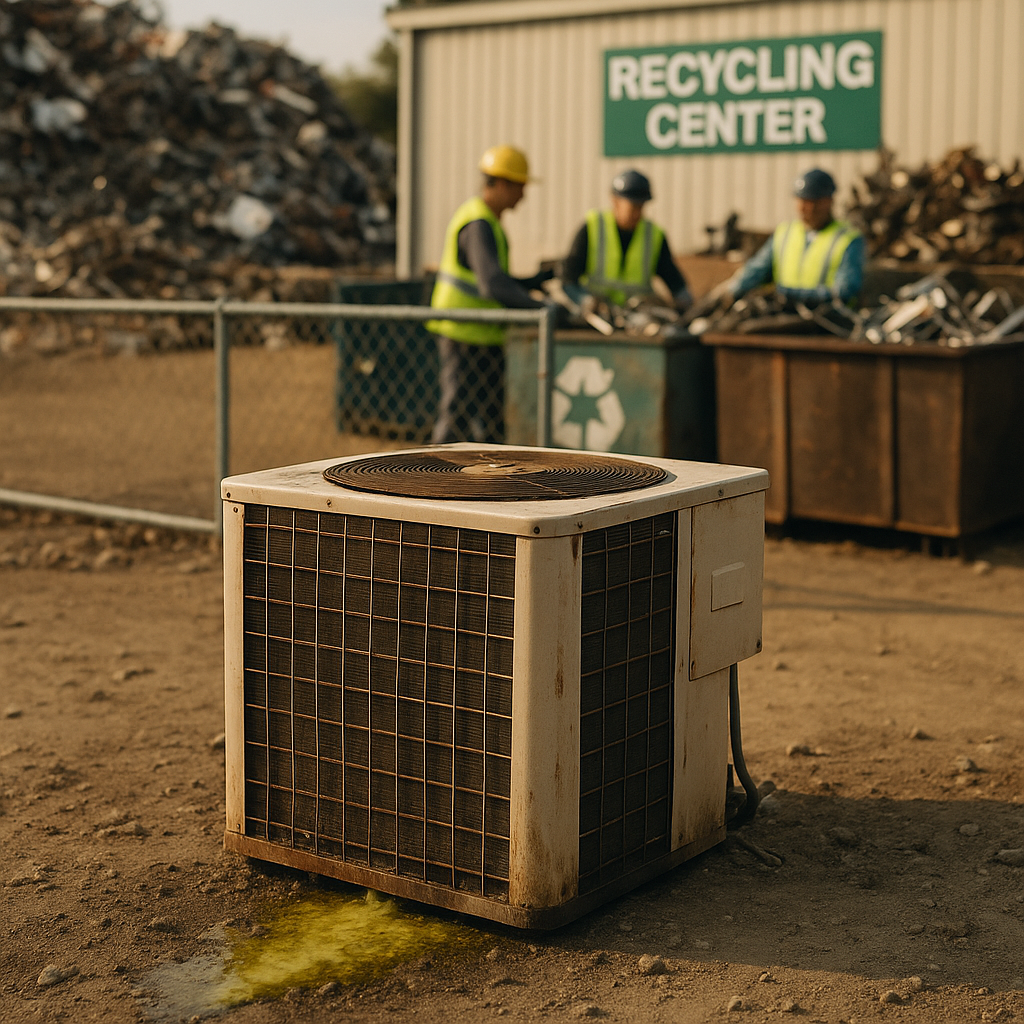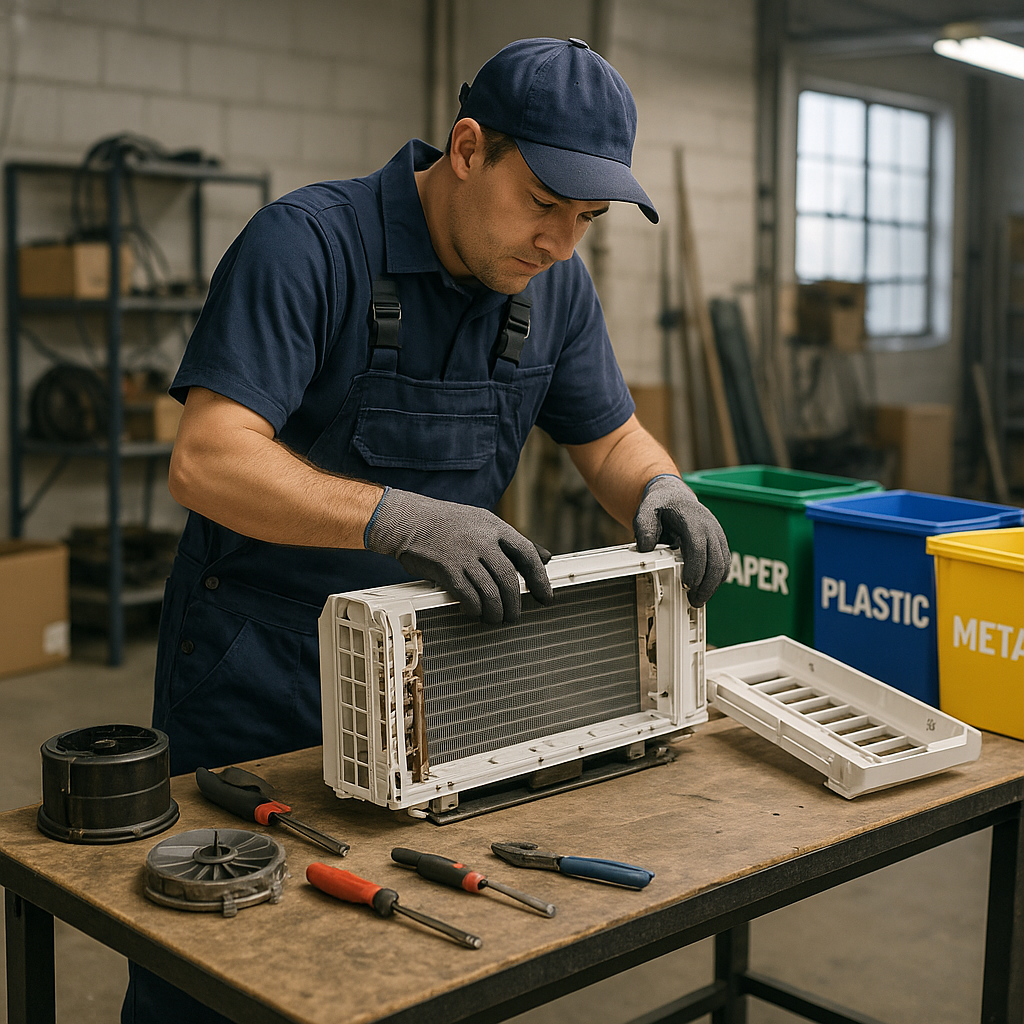5901 Botham Jean Blvd, Dallas, TX 75215
Eco-Friendly Disposal of Rooftop Air Conditioning Systems
May 13, 2025When commercial air conditioning units reach the end of their service life, their disposal becomes a significant environmental concern. Eco-friendly disposal of rooftop air conditioning systems involves implementing responsible practices that minimize environmental impacts during the removal and recycling of these bulky HVAC units.
Environmentally conscious AC disposal addresses three main challenges. First, it ensures proper handling of refrigerants like hydrofluorocarbons (HFCs), which are powerful greenhouse gases more damaging than carbon dioxide. Second, it facilitates the recovery of valuable materials, including copper, aluminum, and steel components, that can be repurposed. Third, it significantly reduces the volume of waste destined for already overcrowded landfills.
With increasing regulatory oversight through laws like the Clean Air Act, proper disposal isn’t just environmentally responsible—it’s a legal necessity. California and many other states have enacted specific requirements for handling these units, with significant penalties for non-compliance. Fortunately, recycling centers and certified HVAC professionals now offer specialized services to manage this process safely and effectively.
Why is Proper Disposal of HVAC Systems Important?

HVAC systems contain hazardous materials that pose environmental risks when improperly disposed of. Refrigerants in these systems are particularly concerning, as they can be significantly more damaging to the atmosphere than carbon dioxide when released. A single improperly disposed air conditioning unit can release greenhouse gases equivalent to driving a car for over 1,000 miles.
Older HVAC units often contain chlorofluorocarbons (CFCs) or hydrochlorofluorocarbons (HCFCs) that damage the ozone layer. These chemicals, which act like Earth’s sunscreen, increase risks of skin cancer and cataracts while contributing to global warming.
Beyond refrigerants, HVAC systems contain metals, plastics, and electronic components that can leach toxic substances into soil and water. When these units break down in landfills, rainwater can carry dissolved heavy metals and pollutants into the ground, contaminating groundwater and nearby water sources.
The Environmental Protection Agency (EPA) has established strict guidelines under Section 608 of the Clean Air Act for disposing of refrigeration and air conditioning equipment. These regulations make it illegal to knowingly release refrigerants into the atmosphere. Only EPA-certified technicians can legally handle refrigerant recovery before disposal.
According to the National Resources Defense Council, the global HVAC industry contributes approximately 1 billion tons of greenhouse gas emissions annually. Project Drawdown estimates that preventing 100% of refrigerant leaks could reduce carbon dioxide emissions by 57.15 gigatons over 30 years, resulting in lifetime savings of $622.73 billion.
Valuable Resource Recovery
Proper HVAC disposal isn’t just about preventing harm. It’s also an opportunity to recover valuable materials. The EPA’s Responsible Appliance Disposal program notes that recycling an air conditioner can yield up to 65 pounds of recyclable materials, including copper, aluminum, and steel.
These recovered materials can be processed and reused in manufacturing new products, reducing demand for virgin resources. For instance, copper from AC coils can be melted down for new electrical wiring, while recycled plastics find use in various consumer goods.
| Refrigerant | Type | Ozone Depletion Potential (ODP) | Global Warming Potential (GWP) |
|---|---|---|---|
| CFC-11 | Chlorofluorocarbon | 1.0 | 3800 |
| CFC-12 | Chlorofluorocarbon | 1.0 | 8100 |
| HCFC-22 | Hydrochlorofluorocarbon | 0.05 | 1810 |
| HFC-134a | Hydrofluorocarbon | 0.0 | 1430 |
| HFO-1234yf | Hydrofluoroolefin | 0.0 | 4 |
| R-410A | Hydrofluorocarbon | 0.0 | 1924 |
| R-404A | Hydrofluorocarbon | 0.0 | 3922 |
Non-compliance with disposal regulations carries severe penalties, including EPA fines of up to $37,500 per day for violations. Beyond legal consequences, improper disposal contributes to long-lasting environmental damage through the release of harmful substances that accelerate climate change.
What are the Best Practices for Eco-Friendly HVAC Disposal?

Proper disposal of HVAC systems is crucial for environmental protection and resource conservation due to the hazardous materials they contain. Let’s explore key practices for eco-friendly disposal.
Professional Refrigerant Recovery
Refrigerants like hydrofluorocarbons (HFCs) are potent greenhouse gases that can cause significant environmental harm if released improperly, with a warming potential much greater than CO2.
Only EPA-certified technicians with 608 certification should remove refrigerants from HVAC systems. This is both environmentally responsible and legally required under the Clean Air Act.
Technicians use specialized recovery machines to safely extract refrigerants without atmospheric release. Once removed, these chemicals can be recycled or sent to approved facilities for proper disposal.
Materials Recycling and Recovery
HVAC systems contain valuable materials that should be recycled. A typical unit can yield up to 65 pounds of recyclables, including copper, aluminum, stainless steel, and plastics.
Metal components are particularly valuable in recycling, reducing the need for new resource mining and manufacturing.
Electronic parts require special handling to prevent toxic substances from contaminating soil and water. Specialized recycling centers can safely process these components while recovering precious metals.
Proactive Replacement Planning
Commercial building managers should implement replacement schedules before systems fail, allowing for proper decommissioning rather than emergency replacements.
Planned replacements enable coordination with certified recycling facilities, ensuring comprehensive recycling services rather than rushed disposal that might bypass environmental safeguards.
This strategy also allows time to research and select new energy-efficient systems, further reducing environmental impact. Advance planning creates opportunities to evaluate newer, sustainable technologies.
Utilizing Specialized Recycling Programs
Several programs exist specifically for HVAC disposal. The EPA’s Responsible Appliance Disposal (RAD) Partners program connects consumers with utilities and retailers committed to proper appliance handling, including HVAC systems.
These facilities have the equipment and expertise to disassemble units completely, ensuring maximum material recovery while safely containing hazardous substances.
Local waste management divisions can provide information about nearby facilities that accept HVAC systems. Some retailers and manufacturers offer take-back programs for old units when purchasing replacements.
Legal Compliance and Documentation
Proper documentation of HVAC disposal is essential for commercial property owners, as many states require tracking the disposal of systems containing refrigerants.
Licensed disposal companies provide necessary paperwork confirming compliance with environmental regulations, protecting businesses from potential fines for improper disposal.
For commercial properties seeking LEED certification or other sustainability credentials, proper HVAC disposal documentation contributes to qualification, demonstrating commitment to responsible environmental practices.
Conclusion: The Future of Eco-Friendly HVAC Disposal
The future of eco-friendly HVAC disposal stands at a promising intersection of regulatory advancement, technological innovation, and environmental responsibility. Enhanced regulations will continue to focus on energy efficiency and emissions, steering the industry toward more sustainable practices. As waste streams become optimized and recycling rates increase, we can expect a significant reduction in the environmental impact from HVAC systems and components.
The shift to low-impact refrigerants will gain momentum as regulatory pressures and technological advancements align. Smart systems using AI and machine learning will further enhance efficiency, while renewable energy integration becomes standard in HVAC operations. By embracing these developments and adopting responsible disposal practices, both residential and commercial HVAC system owners can protect the environment and potentially benefit financially through effective recycling and material recovery. For professional guidance on eco-friendly HVAC disposal and recycling solutions, contact Okon Recycling at 214-717-4083.
